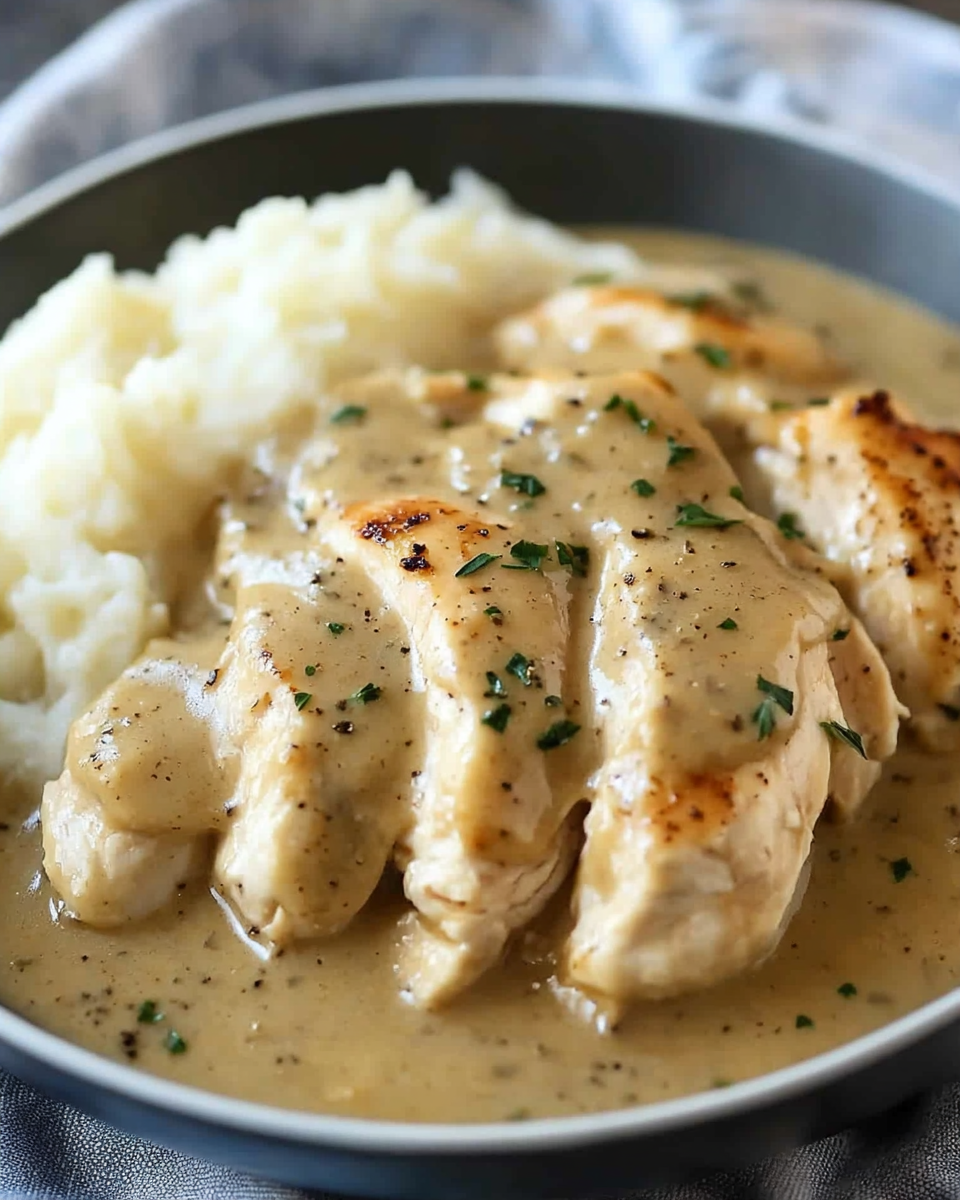Slow Cooker Chicken and Gravy is a simple, flavorful 5-ingredient meal that the whole family will love. Using fresh chicken breasts and a convenient gravy mix, this dish is the epitome of comfort food! It’s a perfect meal for busy weeknights, offering tender, juicy chicken smothered in creamy gravy. You can serve it over mashed potatoes or rice for a hearty dinner that is sure to be a hit at the dinner table.
Full Recipe:
Ingredients
-
2½ pounds boneless skinless chicken breasts (thawed if frozen)
-
10.25 ounces cream of chicken soup (one standard can)
-
1.74 ounces chicken gravy mix (two envelopes)
-
1 cup low-sodium chicken broth
-
½ cup sour cream
-
Kosher salt, to taste
-
Freshly ground black pepper, to taste
-
Cooked rice (for serving)
-
Fresh parsley (chopped, for garnish)
Directions
-
Arrange the Chicken: Place the chicken breasts in the bottom of the slow cooker, spreading them out evenly.
-
Make the Gravy Mix: In a medium bowl, whisk together the cream of chicken soup, chicken gravy mix, and chicken broth until smooth.
-
Cook the Chicken: Pour the gravy mixture over the chicken. Cover the slow cooker and cook on low for about 4 hours, or until the chicken reaches an internal temperature of 165°F (74°C).
-
Shred the Chicken: Once done, shred the chicken directly in the slow cooker using two forks, allowing it to soak up the gravy.
-
Add Sour Cream and Season: Stir in the sour cream, then season with kosher salt and freshly ground black pepper to taste.
-
Serve: Spoon the chicken and gravy over cooked rice or mashed potatoes. Garnish with chopped fresh parsley for a final touch.
Nutrients (approximate per serving)
-
Calories: 380 kcal
-
Carbohydrates: 15g
-
Protein: 42g
-
Fat: 18g
-
Sodium: 870mg
-
Fiber: 1g
-
Sugar: 1g
The Key Ingredients: Eggs, Flour, and Sugar
Ladyfingers are made from a very simple list of ingredients: eggs, granulated sugar, vanilla extract, all-purpose flour, and powdered sugar for dusting. The eggs are the primary ingredient that provides both structure and lightness to the biscuits. The egg yolks create a rich and slightly creamy base, while the whipped egg whites provide the airy, delicate texture that makes ladyfingers so unique. This combination allows the batter to rise well and form the soft, sponge-like crumb.
Granulated sugar is added in two stages: half is beaten with the egg yolks to create a rich, creamy mixture, and the other half is incorporated with the egg whites to help stabilize the meringue. This sugar structure helps the batter hold its shape and creates a crisp exterior once baked. The flour is sifted into the batter gently, ensuring that it combines without deflating the air bubbles created by the whipped egg whites, which is crucial for achieving the desired airy texture.
Vanilla extract adds a subtle depth of flavor, providing a gentle sweetness that enhances the other ingredients. Lastly, powdered sugar is lightly dusted on top before baking, adding a touch of sweetness and helping the ladyfingers to brown beautifully in the oven.
Making the Batter: The Key to Lightness
To make ladyfingers, start by separating the eggs. In a mixing bowl, combine the egg yolks with 1/4 cup of granulated sugar. Using an electric mixer, whip the egg yolk mixture on high speed for about 5-7 minutes until it becomes pale, thick, and slightly fluffy. This process is key to creating the smooth, creamy base for your ladyfingers. Once the egg yolk mixture is ready, stir in the vanilla extract to infuse the batter with flavor.
In a separate bowl, beat the egg whites until soft peaks form. Gradually add the remaining 1/4 cup of sugar while continuing to beat the egg whites until stiff peaks form. The egg whites should be glossy and firm when ready, which will give the ladyfingers their light and airy texture.
The next step is crucial for maintaining that lightness: gently fold the whipped egg whites into the egg yolk mixture in three additions. It’s important to fold, not stir, to preserve the air bubbles in the whipped egg whites. The folding process should be done carefully to avoid deflating the batter, as the air is what gives the ladyfingers their signature texture.
Once the egg whites are fully incorporated, sift the flour over the batter and gently fold it in. The flour should be folded in just until combined to prevent overworking the batter, which could make the ladyfingers dense.
Piping the Ladyfingers: A Simple Yet Elegant Shape
To shape the ladyfingers, transfer the batter to a piping bag fitted with a round tip. The piping bag allows for uniform, clean shapes and ensures the ladyfingers cook evenly. Pipe the batter onto the prepared baking sheet in 3-inch long lines, leaving some space between each one to allow for expansion during baking. The size of the ladyfingers should be consistent for even baking, so take care when piping the dough.
Once piped, lightly dust the tops of the ladyfingers with powdered sugar. This will give them a nice finish and help them form a golden, crispy exterior as they bake. The powdered sugar also adds a slight sweetness and visual appeal to the ladyfingers.
Baking the Ladyfingers: Achieving Golden Perfection
Preheat your oven to 350°F (175°C) and prepare a baking sheet lined with parchment paper. This helps prevent the ladyfingers from sticking to the pan while they bake.
Bake the ladyfingers for 12-15 minutes or until they are lightly golden and spring back when touched. It’s important to monitor them closely as the baking time can vary depending on the oven. Once baked, they should have a firm exterior with a light, soft crumb inside.
After removing the ladyfingers from the oven, let them cool for a few minutes on the baking sheet before transferring them to a wire rack to cool completely. Cooling the ladyfingers allows them to set and firm up, ensuring they retain their texture when you use them in desserts or enjoy them on their own.
Serving the Ladyfingers: Perfect for Layered Desserts or Snacking
Ladyfingers can be used immediately after cooling, or stored in an airtight container for up to a week. They are perfect for assembling layered desserts like tiramisu or charlotte, where their delicate texture will absorb flavors from coffee, liqueurs, or creams. You can also enjoy them as a simple snack, serving them with whipped cream or fresh fruit for a light and refreshing treat.
If you’re using them in a layered dessert, the ladyfingers will absorb the surrounding flavors, becoming a soft and flavorful base for the cream layers. Alternatively, they can be served with a cup of tea or coffee for a classic, simple dessert.
Nutritional Information
Each homemade ladyfinger contains approximately 120 calories, with 24 grams of carbohydrates, 2 grams of protein, and 2 grams of fat. The sugar content is 14 grams per serving, contributing to the slight sweetness that makes these biscuits so delightful. The fiber content is minimal, but ladyfingers are an excellent source of calcium (278 mg) and provide a small amount of iron (1 mg). Their moderate calorie content and relatively low fat make them an ideal choice for a light snack or dessert.
Conclusion: A Light and Delicious Treat
Homemade ladyfingers are a simple yet versatile treat that can be used in a wide variety of desserts. With their light, airy texture and subtle sweetness, they are the perfect base for many classic layered desserts like tiramisu or charlotte. The delicate crumb, combined with the rich flavor of vanilla and the crisp exterior, makes them an irresistible treat on their own as well.
While ladyfingers may seem complicated to make at first glance, this recipe is surprisingly easy and requires just a few basic ingredients. Once you master the technique of gently folding the egg whites into the batter, you’ll be able to make these delicious biscuits with ease, adding a homemade touch to your favorite desserts. Whether served as part of a dessert or enjoyed on their own, these homemade ladyfingers will bring a touch of elegance and lightness to any occasion.

